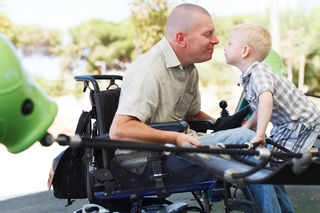Environment
5 Things Adults Unlearn
3. We should search for commonalities before differences.
Posted December 21, 2016

If my kids, ages four and nearly two, and I woke up tomorrow morning and found a dragon in our living room, my son’s top concern would be what we should name it, and my daughter would probably try to hug it. I haven’t yet taught them that if you see a dragon, you should proceed with caution, because I believe them to be fictional and quite likely dangerous.
Every single thing we know today as adults, we had to learn at some point in our development. But there are some things that my kids intuitively grasp without my help. Fro example, they and nearly everyone I meet below the age of four just rolls with it when it comes to disability. Ableism hasn’t taken hold yet. Here are five ways I’ve seen young children display an understanding about disability that unfortunately, most adults struggle with.
1. There’s nothing shameful about having your butt wiped.
We recently had one of my son’s friends over to our house, and my son was trying his hardest to impress her. He showed her his extensive dinosaur collection and even let her hold the items in his treasure chest—the highest honor. Yet, without the slightest ounce of modesty, he interrupted their play date to loudly announce, “I have to poop!” He then ran to the toilet and carried on a conversation with her while taking care of it. Shortly after, she too needed to poop and didn’t think twice about asking me to come in when she was done, already waiting with her butt in the air.
People with disabilities and their personal care assistants know this lesson. Dependence in the bathroom becomes mundane and taboos surrounding bodily functions go out the door. However, when non-disabled people think about disability, needing to rely on someone else’s help for transferring to a toilet or wiping often instills fear and disgust: If I had to live like that, I’d kill myself, they say, forgetting that it was once commonplace for all of us.
2. It’s OK to ask for help when you need it—and, at other times, to turn it down.
My kids can’t tie their shoes or read a book, (and we’ve already covered butt-wiping), so they constantly call on others for help. However, when they don’t need help, they really let me know it. Doing so typically involves a shout of: “I can do it myself!" And they're deeply insulted that I would try to assist them with something they have mastered.
People with disabilities might ask for help at times, but at other moments prefer to do something without help, knowing that help can be counterproductive (e.g. you should never push a wheelchair or open a door for someone unless you have been asked to). Children get that it’s OK to be complicated when it comes to our needs.
3. We should search for commonalities before differences.
Here’s a recent conversation I had with my son while we looked at a photo of the Geico Gecko.
- Carver: "Hey, he looks like me!"
- Me: "I don’t see that. Like at all."
- Carver: "Really? Huh."
I didn’t press further. Apparently, the lines between his body and the gecko’s weren’t as different in his mind as they were in mine. Several children’s movies (ET, Lilo and Stitch, The Iron Giant) show kids befriending and harboring aliens that everyone else wants to cage up or eliminate. While these examples are fictional, this impulse of children to embrace differences or even celebrate them as something cool, rather than stigmatizing, is grounded in reality. Like my son’s mysterious connection to the Geico Gecko, kids see commonality before difference, and my guess is that it’s because they simply haven’t lived long enough to learn a definitive version of what “normal” is.
4. Devices are really useful and cool.

Adults often think of anyone who uses a wheelchair as “wheelchair-bound,” suggesting the device is a tool of oppression rather than one of mobility. Children do not share this perspective. My son recently said to me, “I wish I had a wheelchair. Don’t you, mom?” (He said this in part because he knows he’s not allowed to play on the elevator in our building; that’s only for when a wheelchair rider visits.)
Why would kids think negatively about assistive technology devices? They rely heavily upon them, from their strollers to the stools in front of the sink to their own potty chairs and “special” scissors. Next time you see a parent toting a baby on their back, ask them how they are coping with having a “Bjorn-bound” member of their family.
5. The built environment determines what you can and can’t do.
![By Joncarlopez (Own work) [CC0], via Wikimedia Commons By Joncarlopez (Own work) [CC0], via Wikimedia Commons](https://cdn.psychologytoday.com/sites/default/files/styles/article-inline-half-caption/public/field_blog_entry_images/Doble_Puerta_de_Imaginarium.JPG?itok=DTRV9uOK)
Ask any kid who grew up in the 1980s near the Stonestown Galleria in San Francisco, and they’ll likely remember the joy of walking through the small door at the Imaginarium toy store. In a world built for adults, there was something magical about encountering that door, knowing that it was meant for you. I’ve seen my son react similarly when we’ve visited children’s museums that have lowered sinks and toilets at his height. And when kids encounter the converse, they’re frustrated. Why is that cool toy (that I’ve taken away from my son because he hit his sister with it) out of reach on the top shelf? Kids are constantly learning what people with disabilities experience every day: What you can or can’t do, and even your sense of belonging vary with the surrounding environment.
I wish I could say that my takeaway from these observations is optimism that the next generation is growing up with a keen understanding of disability. Alas, my hunch is that instead, it reminds us that we only gradually learn to make negative and stigmatizing assumptions about disability. As children grow up, they often become fixated on difference, and don’t hesitate to point it out—“Your teeth are yellow!”; “That boy is wearing a dress!”; “You don’t have an arm!” When they do this in front of their parents, it is often quickly shut down with, “Don’t stare, that’s rude!” But this teaches kids that the difference is shameful. And when their door for acceptance of difference is slammed shut, children can be especially cruel to other children, resulting in social exclusion and bullying.
Ableism is a learned process, which gives us hope that we can teach lessons that allow us to reconnect with the messages we grasped more easily in our youth. I’m working on that with my kids every day. That warning about dragons being fictional and potentially dangerous might have to stay on the back burner.




